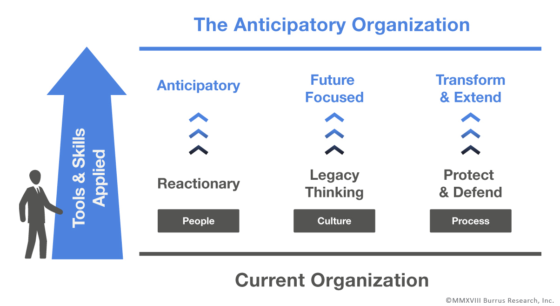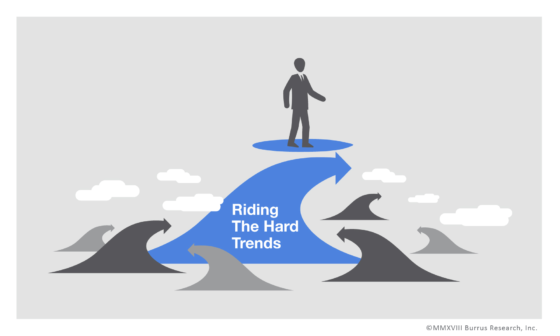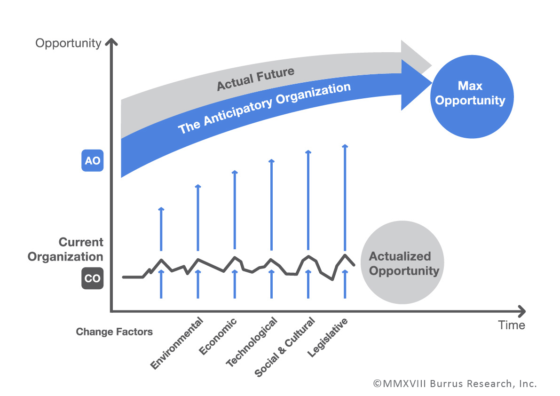Implement Anticipatory Solutions Instead of Reactive Responses

In years past, many businesses have succeeded with an agile, reactive approach to business where they respond to climate, competition, and social circumstances in an "after the fact" way. This focus was predominantly on responding to disruptions as they came in, putting out fires to solve issues.

As many businesses have perfected this approach, a new leadership model is now needed to stay ahead of the competition. Instead of reacting with agility, modern business leaders are taking a more proactive route and, more importantly, responding with an Anticipatory approach.
How do you do this, though? As a business leader, how is it possible to anticipate where the future of your business or industry as a whole is going, use an Anticipatory mindset to find solutions to the world's issues, and, above all, go from reactive to proactive in your response?
Let's help guide you in this productive direction by way of exploring an example of a business in an industry that directly impacts us, especially following the disruption of COVID-19--the hotly discussed supply chain.
Flexport: Fixing the Supply Chain with Hard Trends and Soft Trends
Instead of merely reacting to issues as they come, the most successful business leaders and executives of today focus on Hard Trend future certainties that they can leverage and the Soft Trend future possibilities that come with them.
Hard Trends are the types of trends that we know will happen while Soft Trends are those that are not guaranteed. Let's take the company Flexport, for instance. Flexport is a supply chain business that focuses on improving the world's supply chain so businesses can exponentially enhance the customer buying experience. But with the massive disruptions facing the supply chain since the coronavirus pandemic, how is this possible?

Flexport set out to answer this by identifying a Hard Trend that they cannot change far outside of their desire to fix the supply chain. With the continued digitization of business processes worldwide coupled with the constant customer need for quick information, is the world going to continue toward digital technology and data consumption or would the world go back to the stone age?
Obviously, consumers are not looking to go back, so Flexport decided that neither should they.
By highlighting the future certainty that all customers, both business and individual, were going to continue toward wanting the transparency of instant gratification that digital information provides, Flexport identified a gap in what the supply chain currently offered and, as such, their business model closed this gap, meeting customer needs where their competition did not by digitizing all aspects of the current supply chain.
Now, customers of all kinds can track where packages, shipments, and various goods are along the supply chain, and their software can thus be leveraged exponentially by those that ship said goods.
By differentiating between Hard and Soft Trends, you can identify where industry problems are persisting long before they spiral out of control, what is currently offered, and where business operations can be improved for the greater good. This allows you to be a pioneer in a new technological evolution!
Invest in Technology That Helps
Digital technology itself is a Hard Trend that none of us can evade with agility, as I have written about previously. We will never go back to the era of flip phones or dial-up internet. Instead, exponential technological advancements are always paving new ways for impactful business opportunities.

Let's go back to my Flexport example for a moment. This software development company identified that the supply chain had gaps in transparency. As such, by realizing that transformative digital technology is a Hard Trend that would only continue to improve, it was quickly apparent to them that leveraging certain aspects of digital data collection for supply chain software would greatly address those common customer pain points, giving all customers the transparency that many were unaware they needed.
Flexport is just one example of evidence that companies looking to make exponential differences must not only leverage an Anticipatory mindset and avoid excessive agility, they should also leverage the transformative digital technology available today. Thinking exponentially about technology is key as well.
While Flexport is a software development company, there are thousands of businesses that will utilize Flexport's software to benefit their shipping and receiving operation, and just as many might even identify gaps in what Flexport has and find ways to improve upon those systems themselves--a way in which innovation for their specific industry stems from the inside out.
Don't Run - Risks Are a Positive Thing
 Perhaps the most important reality that any budding Anticipatory Leader or Anticipatory Organization must accept is that every business move comes with a variety of risks, and these risks can be scary. Because of fear, it is easy for many business leaders to fall back into a legacy mindset, living by the mantra that "this worked before, so it must work now."
Perhaps the most important reality that any budding Anticipatory Leader or Anticipatory Organization must accept is that every business move comes with a variety of risks, and these risks can be scary. Because of fear, it is easy for many business leaders to fall back into a legacy mindset, living by the mantra that "this worked before, so it must work now."
However, this risk-averse mindset is how businesses fall behind and lose customers. Both business and consumers do not stand still. Nothing stays in stasis forever, and new needs arise, whether they are initially obvious or not, as witnessed in the Flexport example and their supply chain transparency software that essentially pre-solved a problem many customers didn't realize they had.
I implore you and perhaps even challenge you as an Anticipatory Leader to take risks knowing that if you master Hard Trends, future certainties impacting both your industry and the world outside of your organization's four walls, risk becomes less risky. Knowing where you are heading and knowing where you may potentially run into obstacles provides a similar transparency that Flexport has brought to all of us waiting patiently on deliveries in the supply chain.
If you are tired of being exhaustively agile, putting out business fires, and responding to difficulties with a fear of risk, it is time to make a drastic change. Take your business's future by the reins and carve your own path with my Anticipatory Organization Learning System!









